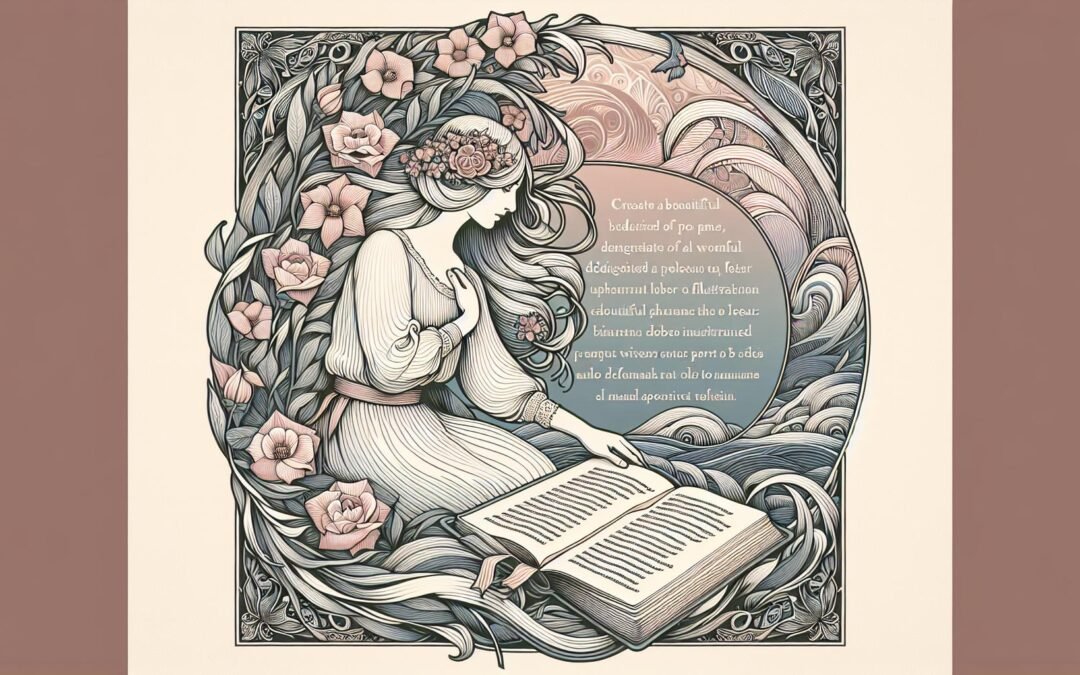Beautiful poems for her reside where devotion meets linguistic invention, becoming gifts and revelations in the same breath. This tradition flourishes across centuries, continually reshaping perceptions of love, worth, and individuality. From early lyric fragments to contemporary free verse, these works draw readers toward intimacy and wonder. For those seeking structured inspiration, browse rhyming love poetry to trace echoes of this enduring address.
Beautiful Poems for Her: Historical and Thematic Dimensions
The lineage of poems addressed to women traverses remarkable evolutions in sensibility, form, and conscious intent. Sappho transformed desire into spare music, her lines shimmering with admiration and longing for real presence. Petrarch’s devotion to Laura radiated through tightly-wrought sonnets, where beauty signified a ladder toward transcendence while also animating the torments of absence. Later, Shakespeare redirected the sonnet’s energies toward complexity and self-questioning, making love both mirror and riddle. Early traditions prioritized symmetry in both subject and language, often reflecting ideals drawn from myth and courtly code.
Within English metaphysical poems, the beloved emerges as both anchor and provocation, inviting metaphors that fuse intellect and vulnerability. John Donne repeatedly plays lover against philosopher, turning the woman he addresses into both muse and equal interlocutor. The Romantic period splits open conventional praise, finding depth not in surface grace but in the interplay of melancholy, memory, and the transformative power of longing. Poets from this era map affection onto landscapes, letting rivers or winds reflect the beloved’s qualities through soft allegory. Later, twentieth-century visionaries like Pablo Neruda and Anna Akhmatova invert traditional scripts. Here love stutters into the unspeakable, enfolded with pain, memory, or the pressure of political violence.
Themes and Emotional Vocabulary
Addressed poems gather a host of overlapping themes: longing, admiration, celebration, and the articulation of inner realities through an external muse. Love provides immediate urgency, marking the language with signals of devotion, fear, vulnerability, or hope. Physical attributes may invite notice, but the gaze quickly transcends flesh to dwell among intellectual sparks or emotional strength. Contemporary authors, responding to shifting models of gender and agency, emphasize autonomy, specifying the beloved’s independence and interior complexity. For examples challenging stereotypical archetypes, visit romantic poems for a beautiful woman for readings from modern poets.
Motifs drawn from landscape or celestial imagery recur across centuries and languages. Woods, rivers, clouds and seasons transform internal states into seen reality, permitting poets to inscribe longing within the world’s cycles. In many Emily Dickinson lyrics, nature’s smallest detail stands in for emotional revelation. Meanwhile, metaphors deepen or subvert meaning: laughter as water, hands compared to gardens, presence likened to new sunlight. These devices shape connection between immediate affection and the larger symbolic environment.
Florals, colors, and sensations act as shorthand for moral or emotional reality. Roses and violets highlight purity or resilience; wind and light infiltrate metaphors describing comfort or absence. Meanwhile, some traditions foreground paradox. Certain poets revel in contradiction, sustaining tension between reverence and questioning affection’s illusions. Ambivalence becomes a motif, registering as admiration sharpened by memory or realism. Modern writers, sensitive to inherited clichés, resist ornament for its own sake and favor portraits grounded in lived detail.
Expression and Form in Beautiful Poems for Her
Style across these works moves restlessly. Courtly forms once lent a ceremonial grace, infusing lines with ritual distance. As language modernized, immediacy prevailed. Contemporary poems favor vivid compression or casual speech, prioritizing raw emotion over prescribed constraint. This shift signals a desire to honor individuality and truth. For an array of dynamic approaches, browse Alfred Lord Tennyson or explore the sharp economy of Layli Long Soldier for further examples.
Lexis and structure encode emotion as much as content. Alliteration and consonance thread music through composition, as in “soft-scented silence surrounds your silhouette.” Repetition marks devotion, establishing incantatory patterns where the beloved’s name or traits become sacred refrain. Rigid structures—sonnet or villanelle—concentrate emotion, demanding artful discipline. By contrast, free verse or spoken word fragments allow room for confession, pause, and the jagged overflow of feeling. Find additional context on evolving forms with notable poetry collections spanning different eras.
Imagery and the Power of Specificity
Imagery serves as both entrance and defense. Metaphors can elevate familiar moments—soft hands, whispered promises—while ingeniously escaping sentimentality. The strongest verses resist abstraction, letting specific gestures or details ground their praise. A beloved’s gaze read as “the hush following thunder,” or a moment in shared silence amplified as testimony, pulls the poem toward lived authenticity.
Tone fluctuates with lexical intention. Opulent address, as in “you glow brighter than the summer’s golden zenith,” contrasts with stripped realism, favoring direct declarations: “You laugh, and I remember childhood.” Emotional timbre sharpens where intimacy collides with self-awareness, blending reverence and startling honesty. For modern variations, contemporary poets are reshaping what it means to address another in verse.
Rhetorical technique also influences intimacy. Rhetorical questions, unstable second-person address, and staccato enjambments create atmosphere or distance. Some writers lure the reader into complicity; others hold them at considered remove. Recent poems actively challenge the supposed universality of feminine archetype by foregrounding difference and contradiction. By allowing uncertainty or vulnerability into the address, the contemporary “beautiful poem for her” radiates complexity.
Across traditions, language morphs to inhabit local idiom, regional rhythm, or dialect. Persian lyric, for instance, imbues spiritual longing with physical description, translating fervor into elevated language. Spanish and Russian poetics bring fresh syntactic patterns, making the beloved a site of philosophical and political debate as much as intimate confession. To explore these traditions further, visit Neruda’s canon or hear Akhmatova’s echoes within contemporary verse.
Visual and sound motifs intertwine, shaping an experiential encounter for reader and beloved alike. Where one tradition privileges cascading images, another sharpens intimacy through spare address. Such difference resists formula but points toward a single purpose: to consecrate connection through the artistry of attention.
Diversity in approach strengthens resonance. Each evolution signals poets’ continuing search for forms flexible enough to embrace individuality without sacrificing music, for language able to bear the pressures of desire and memory. These poems become laboratories for emotional truth, testing the limits of praise, disclosure, and self-exposure in the presence of “her.”
For further reflections on language art, see The Poetry Society and Poetry Foundation.

